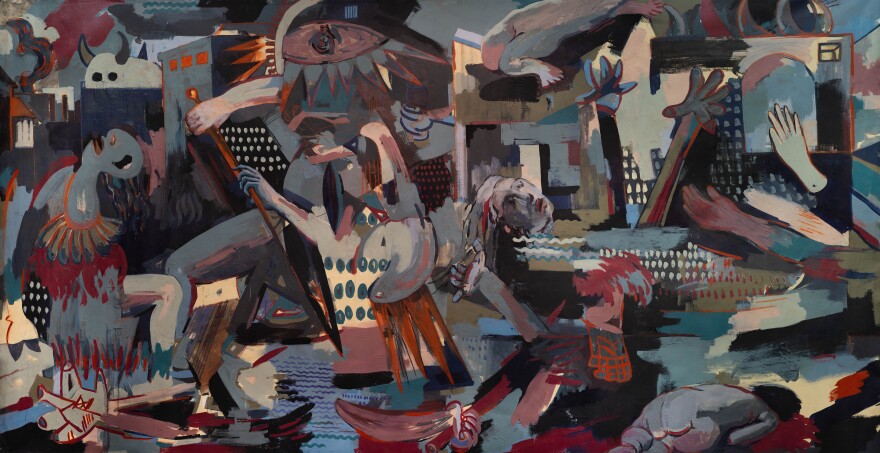Painter Reem Bassous drew on history, psychology, philosophy, current events, and her childhood experiences in war-ravaged Beirut to create her current paintings. HPR’s Noe Tanigawa reports, her students at Leeward Community College are given tools for expression and an opportunity to do research and synthesize their own experiences too.

Last chance to see “Endless Red,” new paintings by Reem Bassous, is tomorrow, Wednesday, 2-7pm, 4/24/2019 at Aupuni Space in Kaka‘ako.
"I have ideas that will fuel me until the day I die. You really want to be immersed in that level of research."

Painter, educator, Reem Bassous is a gracious host in her studio at Lana Lane, that increasingly rare oasis of scruff and shade in Kaka‘ako. Her show, Endless Red, is in Aupuni Space next door.
Bassous: So Endless Red is a very in-your-face narrative depiction of my discontent, or my rage with the political situation both in the Middle East and in the U.S.
Filling an entire wall, Endless Red riffs on two Western classics: Picasso’s Guernica, and Rubens’ Massacre of the Innocents in imagery and composition. Bassous got out the color journal she kept, detailing mixtures of 5-10 different hues that might go into any one red.
Bassous: It was quite unexpected to arrive at this kind of recipe because as you can see there’s some green there as well which I always knew was going to be in the mix, but it took a while to arrive at this.

Painters know colors like flavors; a little green in red can be like adding umami.
Bassous says she has her students at Leeward Community College do extensive color journaling.
Bassous: We have color charts that are really detailed. At first they think it’s a little onerous, but actually they totally get it and they become a little obsessive with how they mix the color. And when you teach students to mix color at such a complex level, it’s a game changer, because not only do they learn how to harmonize the colors, but they also mix unusual colors that, that’s what you want as a painter. You want people to come and see you work and think, Oh my goodness, I wonder what color that is, it’s so beautiful! I mean that‘s not the only thing you want, but it’s definitely one of the things you want.
Bassous found that pairing students up contributes to both camaderie and accountability.
Bassous: Art is a very important way for people to be heard and a lot of these students at Community College have not been heard up until this point. It’s important to give them that avenue to explore who they are and to give them permission to express. It’s not that anything goes, again, this is not art therapy, but through a lot of foundation and structured exercises, there is a way to get very in depth with respect to who you are as a human being, and to be heard. That's what keeps them coming back.

It's one thing to focus on a topic, theme, or problem, and another, to then begin researching words, images, ideas, symbols, histories, feeling through human thought on the subject.
At some point, though, you've got to own all the research and why you even cared to begin with and start doing something.
Bassous: But the minute you start working on the surface, the surface also has other ideas, so the image may or may not turn out the way you had preconceived it. And more often than not, if you’re really being in touch with the process, you end up with something that deviates very far from your original thought.
Bassous: You have to have that openness and that listening ear to what the painting needs and what it’s telling you should happen on the surface. That’s the dialog all artists wait for.
Bassous: What we do as painters is not coloring. It’s not sofa decoration, it’s not decoration period. It’s a lot of research, it’s a life of research and study. That’s what makes it so exciting.
The Enless Red exhibtion statement was written by Bassous' daughter, Aiyah.
Contraband
I am birthed into a world of cinderblock
Cages, they are
Gridded, tiles on the floor under society’s
Feet, they are
Trodden, branded blue with the banners of the benevolent
And they dance with the dust in
The wind.
Cloth-footed warriors, clad in plastic weapons of war
Salute us
“Marhaba”
They know no better.
Their mothers, skinless creatures of ruin,
Emerge, moribund,
Arms wide, they greet us in tongues
Foreign but familiar, forgotten, fading
Like the writing on the wall they plead with me,
Gentle cries of the un-gentrified that nobody else will hear,
Rendered deaf by torpedoes, explosions of white noise to block out the sobbing.
It is hot as sandpaper musings threaten to imbibe me
And they do,
Ramshackle breaths feed
Condemning stares
When heat turns to flame turns to ash
I am unprepared
Torpifying tortured lungs
Coughing black blood
Burning like flame- sharper,
They are needles, poking and prodding and praising “habibi”
They are claws.
I wander
Until suddenly pain has a name and it is “Go Home!”
Home.
What is home?
I have no home
And so I make one in the tear gas,
In the blue bands of the benevolent,
Becoming a tin man,
Huddled in pockets of ocean,
Hollow,
Flashbacks of lightleaks onto frozen extremities
And orange graveyards.
Clutching the key of return close to my heart
I curse the friendly dark
For being silent.
--Aiyah Bettinger
Bassous: Painting is not comforting, in fact, you have to push the boundaries of what is comfortable and in fact venture very deep into the forest of the unknown. It’s necessary. Otherwise there is no breakthrough that happens, and there is no discovery.
The painting, then, is a record of your courage. And your failings.




